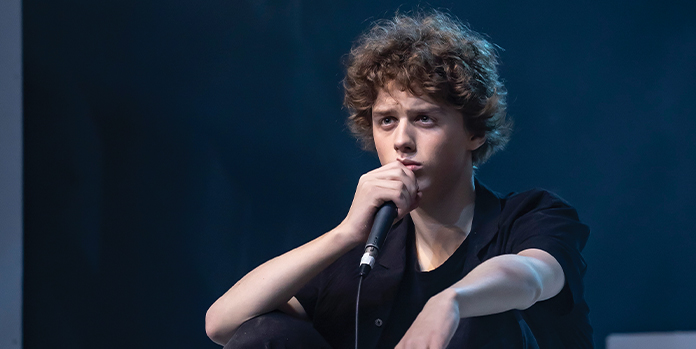Year 11 student, Edgar Stirling, reflects on his role in Cyrano de Bergerac.
Stitched in yellow thread on blazer pockets across Senior School, Drama Colours have two masks, one laughing (Thalia, the muse of comedy) and one crying (Melpomene, the muse of tragedy).
These masks with their exaggerated features, originating in the theatres of ancient Greece, helped audience members in the back rows understand what emotions the characters were feeling.
For the modern actor, including those Melbourne Grammar students who traipse the flagstone in the Quad play or stand under the spotlight on The Old Melburnians War Memorial Hall stage in the August Production, the use of prop masks is sadly wanting, and students must work to find – and then convey – the characters they are gifted.
Unpicking roles is one of the great joys of theatre. From the moment an audition brief arrives, the job of the actor is to find the hints of the person – their disposition – through their dialogue. While exaggeration was the hallmark of Greek drama, modern theatre is about finding the subtle nuance in a character. It is a craft that demands observation and attention to detail.
I always start with a deep dive into the play, reading up on the history of the production. Looking at a script, it is often in the silence between the lines that a character is truly found.
If you visit Grimwade House at lunchtime you’ll see how effortlessly Primary students slip in and out of roles once lunch boxes have been snapped shut – there’s an Avenger, Batman, and Snow White all tearing around the playground at the same time, and the process of assuming a character on stage now feels no different from that same process as a Year 1.
We may not believe with identical conviction that we are going to save the world, but there is a point when actors become nimble enough to shift between the mask we wear in the school playground and the mask on stage.
The School’s recent production of Cyrano de Bergerac has been a true highlight of my 12 years at Melbourne Grammar School. This version of the play by Martin Crimp has been considered an actors’ Cyrano – a pared back iteration set in a stark set and almost devoid of props so that the hero could not even hide behind a prosthetic nose. This allowed Crimp’s lavish language to star, and it meant we had to work hard as actors to make the lines sing.
Perhaps my biggest challenge in assuming the character of Cyrano was finding the physicality of the man. Cyrano is a soldier; older, tougher, and brawnier, and so my own Cyrano had to find a compelling physicality in a scrawnier body. Mine became a Cyrano who was angry, brave, hurt, and wily.
He was damaged by war, in love, and disappointed by love. He was utterly vulnerable. For all the darkness, or perhaps because of the darkness, he was also a tender poet. This part of Cyrano, the wordsmith, was easier for me to imagine and there was a joy in the lyrical script Crimp created.
The theatre is a space in which we slip into character. Standing in the wings, held by the cast, we all take a deep breath before we assume our places on stage.
In that breath, I try to switch into character as effortlessly as I did as a Year 1 under the oak tree.
By the time we can feel the heat of the lights and the beat of the soundscape the work has been done, and our only task is to enjoy the experience before it disappears.



